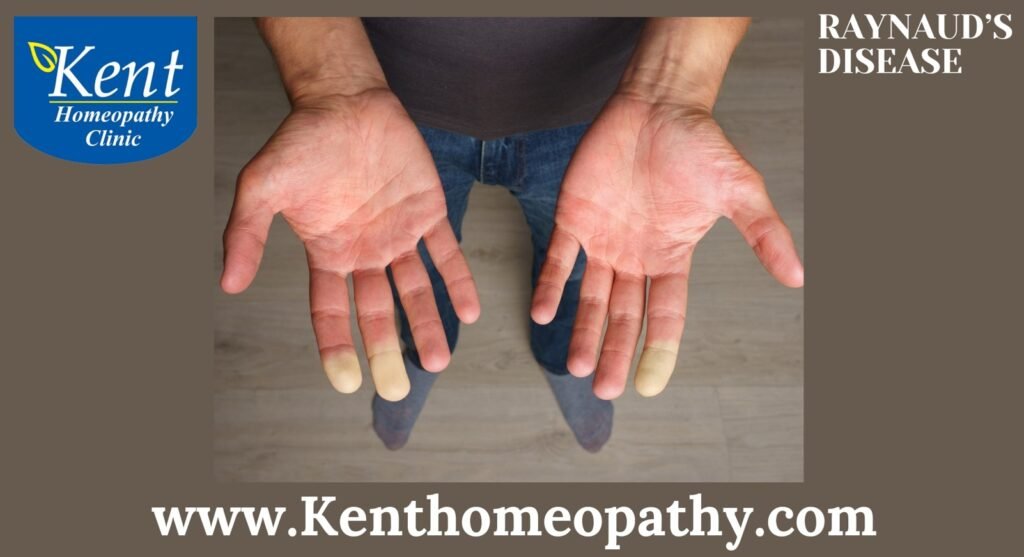Raynaud's disease

Raynaud’s Disease: Unveiling Symptoms, Causes, and Types
Raynaud’s disease, also known as Raynaud’s phenomenon or Raynaud’s syndrome, is a vascular disorder that affects blood flow to certain parts of the body—usually the fingers and toes—resulting in episodes of reduced blood flow and color changes. Understanding the symptoms, causes, and types of Raynaud’s disease is essential for effective management and improved quality of life for those affected.
Symptoms:
- Color Changes in Extremities:
– The primary symptom of Raynaud’s disease is a sequence of color changes in the affected extremities. During an episode, the affected areas may turn white or pale, then blue or purple, and finally, as blood flow returns, they may become red.
- Cold and Numb Sensations:
– Individuals with Raynaud’s disease often experience sensations of cold and numbness in the affected areas during an episode.
- Throbbing or Tingling Sensations:
– After the episode resolves and blood flow returns, individuals may experience throbbing or tingling sensations in the affected extremities.
- Skin Ulcers or Sores:
– In severe cases, repeated episodes of reduced blood flow can lead to the development of skin ulcers or sores, particularly on the fingertips.
- Stress-Induced Episodes:
– Stress and emotional triggers can provoke or exacerbate Raynaud’s episodes.
- Limited Joint Mobility:
– Prolonged or severe cases of Raynaud’s disease may lead to limited joint mobility and deformities in the affected areas.
Causes:
- Vasoconstriction:
– Raynaud’s disease is primarily characterized by vasoconstriction, where the blood vessels narrow, limiting blood flow to affected areas.
- Primary vs. Secondary Raynaud’s:
– Primary Raynaud’s disease, the more common form, occurs without an underlying medical condition. Secondary Raynaud’s is associated with other conditions, such as scleroderma, lupus, or rheumatoid arthritis.
- Blood Vessel Abnormalities:
– Abnormalities in the smaller arteries that supply blood to the skin contribute to the vasoconstriction seen in Raynaud’s disease.
- Nerve Abnormalities:
– Dysfunction of the nerves controlling blood vessel activity may play a role in the development of Raynaud’s.
- Hypersensitivity to Cold or Stress:
– Individuals with Raynaud’s may have an exaggerated response to cold temperatures or emotional stress, triggering episodes.
- Genetic Factors:
– There may be a genetic predisposition to Raynaud’s disease, as it often runs in families.
Types:
- Primary Raynaud’s Disease:
– Also known as Raynaud’s phenomenon, this is the more common and less severe form. It occurs without an underlying medical condition and is often less likely to lead to complications.
- Secondary Raynaud’s Disease:
– Also called Raynaud’s syndrome, this form is associated with other medical conditions, most commonly autoimmune disorders like scleroderma, lupus, or rheumatoid arthritis. Secondary Raynaud’s tends to be more severe and may involve complications.
- Limited Cutaneous Systemic Sclerosis (SSc):
– Raynaud’s disease associated with limited cutaneous systemic sclerosis (SSc) is a subtype linked to the autoimmune disorder scleroderma. It may involve skin thickening and tightness, particularly in the fingers.
- Diffuse Cutaneous Systemic Sclerosis (SSc):
– In this subtype associated with scleroderma, skin changes are more widespread, affecting not only the fingers but also the arms, face, and trunk.
- Overlap Syndrome:
– Some individuals may experience an overlap syndrome, where features of Raynaud’s disease are present along with symptoms of other autoimmune conditions.
Contact to know more
Contact
Timings
Monday to Saturday:
11:00 AM to 02:30 PM
06:30 PM to 09:00 PM
